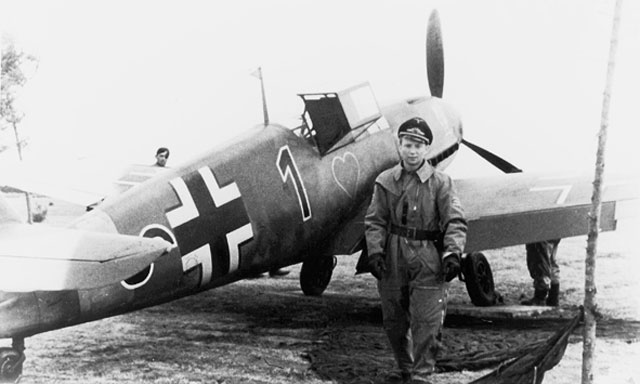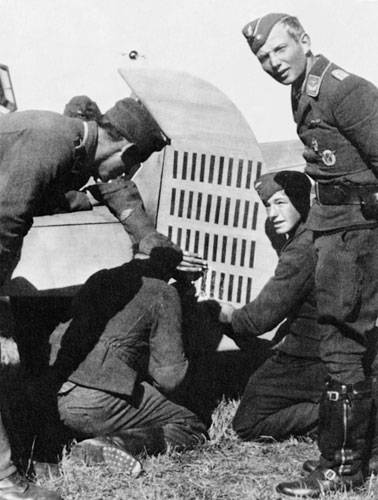
Air Power Editons has kindly supplied the following text extract and images from the first in their "Ace Profiles - The Men and Their Aircraft" series, "Max-Hellmuth Ostermann" by noted aviation historian Christer Bergstrom. This book may be purchased online exclusively through The Aviation Bookshop for GBP £18.99:
From Ace Profiles No. 2: Max-Hellmuth Ostermann
The last day of March, I. and III./JG 54 were fully occupied escorting Ju 87 Stukas against the Volkhov sector where the Soviets, by means of a counter-attack, had managed to re-open the connection with the 2nd Assault Army in the Lyuban Pocket. In the ensuing air combats with Soviet fighters which tried to intercept the dive-bombers, Ostermann and Hptm. Philipp each shot down two enemy aircraft. Thus Ostermann reached his 82nd and Hans Philipp his 100th victory. The next day, Ostermann flew with Lt. Hans-Joachim Heyer of 8./JG 54, and they shot down one MiG-3 each. After this, Ostermann and Philipp were recalled to East Prussia and Hitler’s Headquarters, where they received their awards – Ostermann, the Oak Leaves, and Philipp, the Sword,s – after which they were granted a ten-day leave.
When Ostermann returned on 13 April, he noticed that not only had spring finally
arrived, but that the pilots of 8./JG 54 seemed to have broken their spell of bad luck. A particular cause for celebration was the fact that one of the Staffel’s pilots, Oblt. Rudolf Klemm, had achieved the Grünherzgeschwader’s 2000th victory. This had taken place on 4 April 1942, and it was Klemm’s second personal victory.
During much of April, the melting snow turned the airfields into a quagmire, making any take-off or landing with a Bf 109 extremely risky. Hence, flying was limited to a minimum and this lasted until 21 April.

When regular combat flying resumed, Ostermann noticed a change in himself. The Third Reich awarded its war heroes mainly for individual accomplishments, and nowhere was this more so than in the Luftwaffe – particularly within the Luftwaffe’s fighter arm, where individual victories counted more than anything else. This was a result of the ‘Red Baron’s’ – (Manfred von Richthofen) – chivalrous ‘knights of the air’ mentality which the Luftwaffe’s founder and leader, Reichsmarschall Hermann Göring, had fostered. Being second in command in the Third Reich, the vain Göring had a tremendous impact – probably greater than anyone else – on the criteria for high awards. Hence he heaped his favourites, the fighter pilots, with military awards. Among the German Armed Forces’ first five recipients of the Oak Leaves , three were young fighter pilots – Mölders, Galland and Wick – and they all received them for their high victory scores. The first four recipients of the Swords were fighter pilots – Galland, Mölders, Oesau and Lützow – with the same criteria. Additionally, when an even higher top award was instituted, the Diamonds to the Oak Leaves with Swords, this was for over a year awarded exclusively to fighter pilots as reward for their high victory scores.
German propaganda newsreels, papers and radio broadcasts regularly ran highly charged stories on various fighter pilots’ individual combats, and a highly competitive esprit de corps developed between individual fighter pilots throughout the Luftwaffe. The criteria for receiving such awards was much discussed by the pilots. By June 1941, about 20 victories was the unofficial norm for the award of the Ritterkreuz. But when Ostermann received his Ritterkreuz in September that year, the norm had apparently risen to nearly 30. In February 1942, Ofw. Karl Kempf of Ostermann’s old 7./JG 54 received the Ritterkreuz after having only surpassed the 40-victory mark.
 Military awards were a guaranteed shortcut to a higher status in the Third Reich, particularly in the public’s eye, and this of course had a tremendous impact on the young men in uniform. The honour Max-Hellmuth Ostermann felt bestowed upon him when he met Hitler and received the Oak Leaves from Hitler’s hand, and the coverage in the associated newspapers and newsreels across Germany, had an inevitably strong impact on him. He felt he was no longer the ‘little hare’ that he had previously described himself as. Upon his return to the front line, he was suddenly overwhelmed by an overriding desire to become No. 1, and he felt that this was within reach: He had received his Oak Leaves for 62 victories, and Philipp had received the Swords to the Oak Leaves for 86. But in the meantime, Ostermann had racked up his score to 84. Realising that he was rapidly approaching the day when he would bring home his magical 100th victory – which only three other pilots had been able to accomplish before Hans Philipp – he felt that he was within reach of actually becoming the Luftwaffe’s top scorer. Ostermann could become a giant. Military awards were a guaranteed shortcut to a higher status in the Third Reich, particularly in the public’s eye, and this of course had a tremendous impact on the young men in uniform. The honour Max-Hellmuth Ostermann felt bestowed upon him when he met Hitler and received the Oak Leaves from Hitler’s hand, and the coverage in the associated newspapers and newsreels across Germany, had an inevitably strong impact on him. He felt he was no longer the ‘little hare’ that he had previously described himself as. Upon his return to the front line, he was suddenly overwhelmed by an overriding desire to become No. 1, and he felt that this was within reach: He had received his Oak Leaves for 62 victories, and Philipp had received the Swords to the Oak Leaves for 86. But in the meantime, Ostermann had racked up his score to 84. Realising that he was rapidly approaching the day when he would bring home his magical 100th victory – which only three other pilots had been able to accomplish before Hans Philipp – he felt that he was within reach of actually becoming the Luftwaffe’s top scorer. Ostermann could become a giant.
Max-Hellmuth Ostermann was aware of this, and it also troubled him. He wrote: ‘Suddenly, I was overwhelmed by an incredible inner restlessness. Over and over again I tried to repress that feeling, telling myself that we did not fight for our own ends, but for our country. But the feverish hunt for victory numbers had irrevocably affected me. Earlier I had never felt this fever. I knew that it was dangerous, not only to me, but also to the men whom I led.’
During a free-hunt mission over Lake Ladoga east of Leningrad on 23 April, Ostermann spotted three MiG-3s high above. He decided to attack and they started climbing towards the Soviets, but they had not climbed far before the three Soviet pilots spotted them and dived down to attack. Ostermann skilfully countered the attack through a wide turn at full speed and went after one of the MiG-3s. But the other two Russian fighters pursued his wingman, whom Ostermann immediately turned to rescue and he gave one of the two a brief deflection shot. The shells hit home and it seemed that the Soviet pilot apparently panicked, for he reacted by turning his aircraft sharply to the right thereby ramming the other MiG. Both fell steeply to the ground. One parachute opened. Ostermann then turned in pursuit of the third MiG-3. He chased it all the way to the shore of Lake Ladoga, where a barrage of Soviet anti-aircraft fire forced him to disengage and return to base.
Ostermann’s two victories – achieved with a single burst of fire – were indeed a feat and became the main topic of discussion in the officers’ mess that evening.
Read more in Ace Profiles No. 2: Max-Hellmuth Ostermann
www.airpowereditions.com
AirPower Editions – Cutting Edge Research
Available exclusively online from The Aviation Bookshop for GBP £18.99
Text and Images Copyright © 2008 by Air Power Editions
This Page Created on 11 March, 2008
Last updated 11 March, 2008
Back to HyperScale Main Page
Back to Reviews Page
|
Home
| What's New | Features | Gallery | Reviews | Reference | Forum | Search